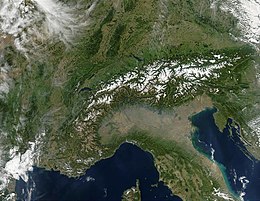Mountain chain
However, if a truncated upland is eroded into a high table land, the incision of valleys can lead to the formations of mountain or hill chains.
The tendency, especially of fold mountains (e. g. the Cordilleras) to produce roughly parallel chains is due to their rock structure and the propulsive forces of plate tectonics.
As a result of orogenic movements, strata of folded rock are formed that are crumpled out of their original horizontal plane and thrust against one another.
The Northern Limestone Alps are, in turn, followed by soft flysch mountains and the molasse zone.
In addition to height and climate, other factors are the layering of the rock, its gradient and aspect, the types of waterbody and the lines of dislocation.



